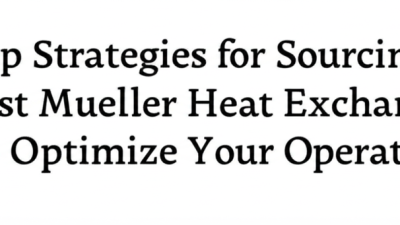Leave Your Message
In today’s highly competitive industrial landscape, optimizing operational efficiency is paramount, particularly when it comes to thermal management systems. Mueller Heat Exchangers stand out as a pivotal component for industries requiring reliable heat transfer solutions. According to a recent report by Research and Markets, the global heat exchanger market is projected to reach $24 billion by 2027, growing at a CAGR of 7.5% from 2020 to 2027. This growth underscores the increasing reliance on advanced heating and cooling technologies, where Mueller Heat Exchangers play a critical role in maximizing energy efficiency and minimizing downtime. As companies strive to enhance their production capabilities, understanding the best strategies to source these high-performance heat exchangers becomes essential. In this blog, we will explore the top strategies for effectively sourcing Mueller Heat Exchangers, ensuring that your operations are not only optimized but also sustainable in the long run.

Heat exchangers play a pivotal role in enhancing the efficiency and sustainability of industrial operations. As industries face increasing demands to optimize resource use and minimize environmental impact, the importance of effective heat transfer solutions becomes evident. Recent advancements in thermal energy management highlight the need for integrated systems that not only enhance performance but also reduce emissions. For instance, the development of combined heat transfer performance for engine systems showcases innovative approaches that significantly boost operational efficiency while meeting regulatory standards.
In addition to traditional methods, the exploration of renewable energy systems has gained momentum, demonstrating the potential of heat exchangers in sustainable building heating and cooling. This transition not only addresses energy needs but also contributes to the decarbonization of industrial sectors. Moreover, the growing interest in air-cooled and plate-shell heat exchangers reflects the market's response to these technological advancements. As industries continue to innovate, selecting the best heat exchangers tailored to specific operational needs becomes crucial in maximizing output and ensuring compliance with environmental requirements.
When sourcing the best Mueller heat exchangers to optimize your operations, several key factors must be considered to ensure efficiency and reliability. First and foremost, it’s crucial to assess the specific requirements of your application. Different industries may have varied demands in terms of temperature, pressure, and fluid types. By understanding the unique conditions under which the heat exchanger will operate, you can select a model that is tailored to meet those needs, enhancing performance and longevity.
Another important factor is the materials used in the construction of the heat exchanger. Mueller offers a range of options, including stainless steel and titanium, each with distinct properties that can affect durability and resistance to corrosion. The material selection should align with the operational environment and the nature of the fluids being processed. Additionally, consider the manufacturer’s reputation for quality and support. Engaging with trusted suppliers can provide peace of mind, as they will offer not only robust products but also essential after-sales service, ensuring that your operations continue running smoothly.
| Criteria | Importance Level | Considerations |
|---|---|---|
| Material Quality | High | Ensure corrosion resistance and thermal conductivity. |
| Efficiency Ratings | Critical | Look for heat exchangers with high thermal efficiency. |
| Size and Dimensions | Moderate | Fit the space requirements of your system. |
| Maintenance Ease | High | Choose designs that allow for easy cleaning and repairs. |
| Cost-effectiveness | Critical | Evaluate long-term ROI versus initial investment. |
| Regulatory Compliance | High | Ensure it meets industry standards and regulations. |
| Vendor Reputation | High | Research vendor reviews and customer feedback. |
When selecting the best Mueller heat exchanger, a comparative analysis against its competitors can illuminate key advantages that may optimize your operations. Recent studies highlight the importance of evaluating thermal energy storage (TES) technologies, suggesting that defining suitable key performance indicators (KPIs) can be instrumental in making informed choices (Energy and exergy assessment...). This is particularly pertinent when you're comparing heat exchangers, especially considering that their efficiency can significantly impact overall operational costs.
Tips for effective sourcing include leveraging market reports that analyze various heat production technologies. For instance, understanding the marginal-cost pricing in competitive markets, such as those for district heating, helps in grasping the financial implications of your decisions. It’s essential to assess if the revenues from various technologies, including heat exchangers, can adequately cover fixed costs, thereby providing a more robust foundation for equipment investment.
Additionally, exploring the comparative performance of heat exchangers through a thermogravimetric kinetic study can help identify optimal operating conditions. This ensures that you are not only selecting the best technology but one that enhances efficiency through continuous performance analysis. Such insights can lead to improved operational effectiveness and reduced downtime, making a significant difference in competitive markets.
When selecting a Mueller heat exchanger for optimal operational efficiency, evaluating energy efficiency metrics is crucial. Key performance indicators such as the thermal efficiency, pressure drop, and heat transfer rate should be at the forefront of your analysis. A higher thermal efficiency signifies that the heat exchanger can transfer the maximum amount of heat with minimal energy expenditure, which translates to reduced operational costs over time. Thoroughly examining these metrics ensures that the chosen heat exchanger not only meets current needs but also aligns with sustainability goals.
Moreover, understanding the relationship between energy efficiency and different design configurations is essential. Factors such as the type of fluid being processed, flow arrangement, and material selection can dramatically influence performance. For instance, a counterflow design may offer superior efficiency compared to a parallel flow setup, particularly in applications where temperature differentials are significant. By considering these parameters and leveraging testing data to compare various models, you can make a more informed decision that enhances both performance and energy savings. This strategic approach will ultimately lead to improved operational output and reduced energy consumption in the long run.
Sourcing the best Mueller heat exchanger is crucial for optimizing operational efficiency and ensuring sustainability in various industrial applications. Leveraging industry insights can significantly enhance sourcing decisions. According to a recent report by the International Energy Agency (IEA), optimizing heat exchangers alone can lead to energy savings of up to 20% in industrial processes, underscoring the importance of selecting high-quality, reliable equipment. Engaging with industry specialists and utilizing databases such as the Heat Exchange Research Institute can provide valuable comparative analysis of different Mueller models, ensuring that procurement aligns with operational requirements.
Additionally, case studies play a pivotal role in decision-making. For instance, a study published in the Journal of Cleaner Production highlighted how a leading food processing company achieved a 15% reduction in operational costs after upgrading their heat exchange systems with Mueller products. By examining real-world applications and performance metrics, companies can make informed choices that not only meet regulatory standards but also contribute to long-term cost savings and environmental sustainability. Adopting a data-driven approach to sourcing can allow businesses to stay competitive while maximizing the effectiveness of their thermal management systems.
